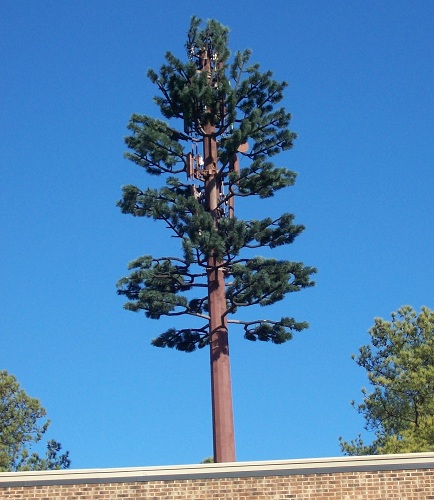Visualizations of networks in the form of “flow diagrams” usually place more visual emphasis on the paths in these networks than on their nodes, thereby creating a representation of spatial relations without any sense of what elements the infrastructure is actually composed of. For Lisa Parks, the main consequence of this approach to network infrastructures is a trade-off between an overview of the entire network, and a more local understanding of the nodes in that network. To return our attention to this overlooked aspect of network infrastructures, Parks uses the antenna tree as a model for a “node-centric and materialist approach to the study of infrastructure” (1).
An antenna tree is more than a communication tower; it is a “symptom of processes of fabrication and installation, state and local regulation, community deliberation, and spatial transformation.” Specifically, disguising modern technology so that it blends in with nature not only conceals the communications infrastructure from view, but even more significantly, “keep[s] citizens naive and uniformed about the network technologies they subsidize and use each day” (ibid.). While Hannah Arendt would define modern technology through the layman’s ignorance of its inner workings, Parks deplores the tendency toward infrastructure illiteracy—which, admittedly, may not necessarily be the same as ignorance about technological hardware. “We describe ourselves as a “networked society” and yet most members of the public know very little about the infrastructures that support such a designation – whether broadcasting, web or wireless systems” (ibid.).
Park’s brief history of antenna trees frames them as a response to public debates about the installation of more traditional antenna towers in the 1990s. Presumably to increase coverage and handle cellular network traffic, the growth of cellular services required the installation of new antenna towers. In response, groups of concerned citizens protested the perceived harm to neighborhood aesthetics and the potential health risks of wireless transmissions. In addition to these residential disputes, groups protested the installation of cellular towers in public spaces like Yellowstone National Park. As Parks observes, these developments complicate the usual rhetoric of wireless advertising (“You can talk anytime anywhere”) by highlighting the conditions of possibility for increased signal coverage: “the (re)allocation of publicly owned natural resources, the installation of new equipment on private and public properties, and the restructuring of lifestyles and communities” (2). All of these are visible for traditional antenna towers.
Antenna trees, on the other hand, conceal these debates, which tend to arise due to the visibility of cellular towers, and they attempt to appease citizens by making communications infrastructures invisible. As Parks admits, some urban infrastructures are commonly, and perhaps necessarily concealed from the public, as is the case with sewer, electricity, and water. However, any practice of concealment raise questions about how to promote infrastructure literacy: “Are there ways of representing cell towers that will encourage citizens to participate in sustained discussions and decisions about network ownership, development, and access? What is it about infrastructure that is aesthetically unappealing? What form should infrastructure sites assume? Should they be visible or invisible?” (3)
As a possible remedy to the common governmental practices of concealing infrastructures, Parks places hope in the work of artists like the German photographer Robert Voit, who produced a series of photographs of antenna trees under the title “Enchanted Wood” in 2005. Beyond this example, the form for infrastructure literacy to take remains open. While they rarely admit as much, scholars of media studies often take for granted that more knowledge about technology would necessary enrich our experience of it. Though I generally agree with this position, I still tend to question its assumption about representations. More visibility may not necessarily promote greater knowledge, and uncovering the invisible politics negotiations that go into the formation of antenna trees may not necessarily put citizens in a better position to make informed decisions about them.
Source
Parks, Lisa. “Around the Antenna Tree: the Politics of Infrastructural Visibility.” Flow, 2009.

